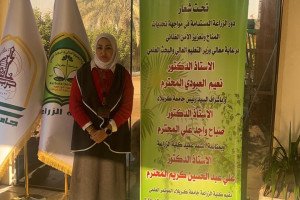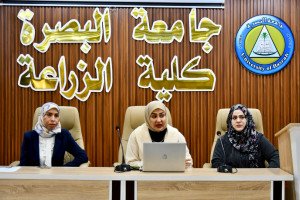
A master's thesis was discussed at the College of Agriculture at the University of Basrah Economic feasibility study of the response of wheat cultivars to methods of adding nitrogen fertilizers. The thesis of researcher Ammar Asaad Abdul Majeed included a study of two factors: the first factor, the methods of adding nitrogen fertilizer (grooves, stripes and scattering), and the second factor includes four varieties of wheat (Rasheed, Baraka, Abu Ghraib-3 and Ibaa-99). The results of the thesis showed that the cultivars were significantly different among themselves in most of the studied traits, as the Abu Ghraib cultivar-3 excelled in the number of days from sowing to 50% spike, and the Rashid variety gave the highest number of days from 50% spike to full maturity, flag leaf area, spike length, number of stems and number of stems. Spikes, spike efficiency, number of grains per spike, grain yield, vital yield, harvest index, protein percentage and protein yield, while Al-Baraka and Abu Ghraib-3 ranked second in grain yield, while Al-Baraka gave the highest average in plant height, and Iba-99. The highest average weight of 1000 grains. The results showed that the method of adding urea in lines was significant in the number of days from 50% spike to full maturity, plant height, flag leaf area, spike length, number of stalks, number of spikes, spike efficiency, number of grains per spike, grain yield, vital yield, harvest index, protein percentage and protein yield, while it gave The method of adding urea sprinkled on the highest number of days of cultivation up to 50% spike and weight of 1000 grains. The results of the economic study showed that the method of adding urea in lines was significantly superior to the average production and the value of the total yield, while the method of adding urea in Gore gave it the highest value of total production costs. The thesis aims to study the economic feasibility of the response of wheat varieties to the methods of adding nitrogen fertilizer. The thesis recommended replanting Rashid and Al-Baraka cultivars in other areas of Basra Governorate, using the method of adding fertilizer in lines, due to giving it a high yield compared to the rest of the varieties. Modern and advanced machines must also be used in order to add fertilizer to the soil in lines and at times of plant growth so that it does not affect the plant. It is also possible to conduct another study for the cultivation of the four varieties using different levels of nitrogen fertilizer by the three methods of addition.







